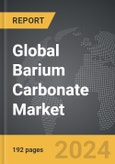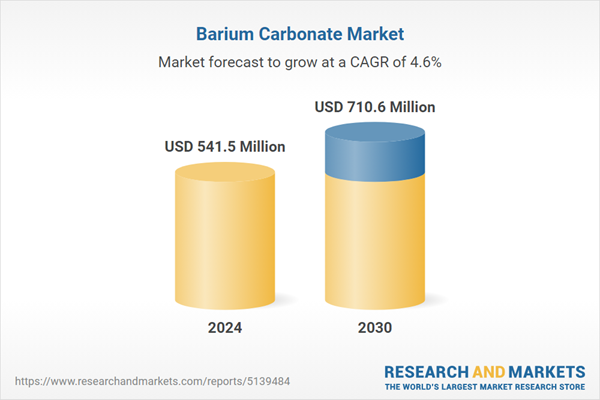The global market for Barium Carbonate was valued at US$541.5 Million in 2024 and is projected to reach US$710.6 Million by 2030, growing at a CAGR of 4.6% from 2024 to 2030. This comprehensive report provides an in-depth analysis of market trends, drivers, and forecasts, helping you make informed business decisions. The report includes the most recent global tariff developments and how they impact the Barium Carbonate market.
Segments: End-Use (Brick & Clay, Ceramic Glass, Photographic Paper Coatings, Barium Ferrites, Other End-Uses).
Geographic Regions/Countries: World; United States; Canada; Japan; China; Europe (France; Germany; Italy; United Kingdom; Spain; Russia; and Rest of Europe); Asia-Pacific (Australia; India; South Korea; and Rest of Asia-Pacific); Latin America (Argentina; Brazil; Mexico; and Rest of Latin America); Middle East (Iran; Israel; Saudi Arabia; United Arab Emirates; and Rest of Middle East); and Africa.
The analysts continuously track trade developments worldwide, drawing insights from leading global economists and over 200 industry and policy institutions, including think tanks, trade organizations, and national economic advisory bodies. This intelligence is integrated into forecasting models to provide timely, data-driven analysis of emerging risks and opportunities.
Global Barium Carbonate Market - Key Trends and Drivers Summarized
Why Is Barium Carbonate Integral to the Glass and Ceramics Industry?
Barium carbonate plays a crucial role in the manufacturing processes of glass and ceramics, serving as a key ingredient that enhances the quality and properties of the final products. In the glass industry, barium carbonate is used as a flux to improve the workability of glass and to enhance its optical properties, such as brightness and clarity. It also helps in reducing the melting point of the glass, making the production process more energy-efficient. In ceramics, barium carbonate acts as a fluxing agent that facilitates the melting of other raw materials, contributing to the formation of a uniform ceramic body with improved mechanical strength and thermal stability. The compound also helps to eliminate impurities such as iron oxide, which can cause discoloration in ceramic products. These benefits make barium carbonate an indispensable component in the production of high-quality glass and ceramic materials.What Are the Technological and Environmental Considerations in Barium Carbonate Production?
The production of barium carbonate involves several technological and environmental considerations, particularly in terms of raw material sourcing and waste management. The most common method for producing barium carbonate is the precipitation process, which involves reacting barium sulfide with sodium carbonate or carbon dioxide. This process requires careful control of reaction conditions to ensure the purity and consistency of the final product. Additionally, the environmental impact of barium carbonate production is a significant concern, as the process generates by-products such as sulfur dioxide, which must be carefully managed to minimize pollution. Advances in production technology are focused on improving the efficiency of the process, reducing energy consumption, and minimizing waste. Moreover, the industry is increasingly adopting sustainable practices, such as recycling by-products and using cleaner energy sources, to reduce the environmental footprint of barium carbonate production.Why Is There Growing Demand for Barium Carbonate in Emerging Markets?
The demand for barium carbonate is growing rapidly in emerging markets, driven by the expansion of the construction, automotive, and electronics industries in these regions. In countries like China and India, the booming construction sector is leading to increased demand for glass and ceramics, both of which rely heavily on barium carbonate as a key raw material. Additionally, the growing automotive industry in these markets is boosting the demand for specialty glass used in vehicles, further driving the consumption of barium carbonate. The electronics industry, which uses barium carbonate in the production of certain types of glass for electronic displays and other components, is also expanding in these regions. As industrialization and urbanization continue to progress in emerging markets, the demand for barium carbonate is expected to rise, supported by the growing need for high-quality construction materials and consumer goods.What Are the Main Drivers Behind the Growth of the Barium Carbonate Market?
The growth in the barium carbonate market is driven by several factors, including the increasing demand for glass and ceramics in construction, automotive, and electronics applications. Technological advancements in production processes are enhancing the efficiency and environmental sustainability of barium carbonate manufacturing, making it more attractive to producers. The expansion of industrial activities in emerging markets is also contributing to the growing demand for barium carbonate, as these regions experience rapid urbanization and infrastructure development. Additionally, the growing emphasis on high-quality materials in various industries is driving the adoption of barium carbonate, as it plays a critical role in improving the properties of glass and ceramics. As these trends continue to evolve, the barium carbonate market is expected to experience sustained growth, supported by ongoing innovations and the increasing demand for high-performance materials.Report Scope
The report analyzes the Barium Carbonate market, presented in terms of units. The analysis covers the key segments and geographic regions outlined below.Segments: End-Use (Brick & Clay, Ceramic Glass, Photographic Paper Coatings, Barium Ferrites, Other End-Uses).
Geographic Regions/Countries: World; United States; Canada; Japan; China; Europe (France; Germany; Italy; United Kingdom; Spain; Russia; and Rest of Europe); Asia-Pacific (Australia; India; South Korea; and Rest of Asia-Pacific); Latin America (Argentina; Brazil; Mexico; and Rest of Latin America); Middle East (Iran; Israel; Saudi Arabia; United Arab Emirates; and Rest of Middle East); and Africa.
Key Insights:
- Market Growth: Understand the significant growth trajectory of the Brick & Clay End-Use segment, which is expected to reach US$211.1 Million by 2030 with a CAGR of a 5.4%. The Ceramic Glass End-Use segment is also set to grow at 4.8% CAGR over the analysis period.
- Regional Analysis: Gain insights into the U.S. market, valued at $141.5 Million in 2024, and China, forecasted to grow at an impressive 7.2% CAGR to reach $156.3 Million by 2030. Discover growth trends in other key regions, including Japan, Canada, Germany, and the Asia-Pacific.
Why You Should Buy This Report:
- Detailed Market Analysis: Access a thorough analysis of the Global Barium Carbonate Market, covering all major geographic regions and market segments.
- Competitive Insights: Get an overview of the competitive landscape, including the market presence of major players across different geographies.
- Future Trends and Drivers: Understand the key trends and drivers shaping the future of the Global Barium Carbonate Market.
- Actionable Insights: Benefit from actionable insights that can help you identify new revenue opportunities and make strategic business decisions.
Key Questions Answered:
- How is the Global Barium Carbonate Market expected to evolve by 2030?
- What are the main drivers and restraints affecting the market?
- Which market segments will grow the most over the forecast period?
- How will market shares for different regions and segments change by 2030?
- Who are the leading players in the market, and what are their prospects?
Report Features:
- Comprehensive Market Data: Independent analysis of annual sales and market forecasts in US$ Million from 2024 to 2030.
- In-Depth Regional Analysis: Detailed insights into key markets, including the U.S., China, Japan, Canada, Europe, Asia-Pacific, Latin America, Middle East, and Africa.
- Company Profiles: Coverage of players such as Athiappa Chemicals (P) Ltd., Chemical Products Corporation, Chemisky Co., Ltd., Hebei Xinji Chemical Group Co., Ltd., Hubei Jingshan Chutian Barium Salt Corp. Ltd. and more.
- Complimentary Updates: Receive free report updates for one year to keep you informed of the latest market developments.
Some of the 38 companies featured in this Barium Carbonate market report include:
- Athiappa Chemicals (P) Ltd.
- Chemical Products Corporation
- Chemisky Co., Ltd.
- Hebei Xinji Chemical Group Co., Ltd.
- Hubei Jingshan Chutian Barium Salt Corp. Ltd.
- Kamman Group
- Nippon Chemical Industrial
- Noah Chemicals
- Noah Chemicals
- Norkem Limited
Tariff Impact Analysis: Key Insights for 2025
Global tariff negotiations across 180+ countries are reshaping supply chains, costs, and competitiveness. This report reflects the latest developments as of April 2025 and incorporates forward-looking insights into the market outlook.The analysts continuously track trade developments worldwide, drawing insights from leading global economists and over 200 industry and policy institutions, including think tanks, trade organizations, and national economic advisory bodies. This intelligence is integrated into forecasting models to provide timely, data-driven analysis of emerging risks and opportunities.
What’s Included in This Edition:
- Tariff-adjusted market forecasts by region and segment
- Analysis of cost and supply chain implications by sourcing and trade exposure
- Strategic insights into geographic shifts
Buyers receive a free July 2025 update with:
- Finalized tariff impacts and new trade agreement effects
- Updated projections reflecting global sourcing and cost shifts
- Expanded country-specific coverage across the industry
Table of Contents
I. METHODOLOGYII. EXECUTIVE SUMMARY2. FOCUS ON SELECT PLAYERSIII. MARKET ANALYSISSOUTH KOREAREST OF ASIA-PACIFICARGENTINABRAZILMEXICOREST OF LATIN AMERICAIRANISRAELSAUDI ARABIAUNITED ARAB EMIRATESREST OF MIDDLE EASTIV. COMPETITION
1. MARKET OVERVIEW
3. MARKET TRENDS & DRIVERS
4. GLOBAL MARKET PERSPECTIVE
UNITED STATES
CANADA
JAPAN
CHINA
EUROPE
FRANCE
GERMANY
ITALY
UNITED KINGDOM
SPAIN
RUSSIA
REST OF EUROPE
ASIA-PACIFIC
AUSTRALIA
INDIA
LATIN AMERICA
MIDDLE EAST
AFRICA
Companies Mentioned (Partial List)
A selection of companies mentioned in this report includes, but is not limited to:
- Athiappa Chemicals (P) Ltd.
- Chemical Products Corporation
- Chemisky Co., Ltd.
- Hebei Xinji Chemical Group Co., Ltd.
- Hubei Jingshan Chutian Barium Salt Corp. Ltd.
- Kamman Group
- Nippon Chemical Industrial
- Noah Chemicals
- Noah Chemicals
- Norkem Limited
Table Information
| Report Attribute | Details |
|---|---|
| No. of Pages | 192 |
| Published | April 2025 |
| Forecast Period | 2024 - 2030 |
| Estimated Market Value ( USD | $ 541.5 Million |
| Forecasted Market Value ( USD | $ 710.6 Million |
| Compound Annual Growth Rate | 4.6% |
| Regions Covered | Global |









